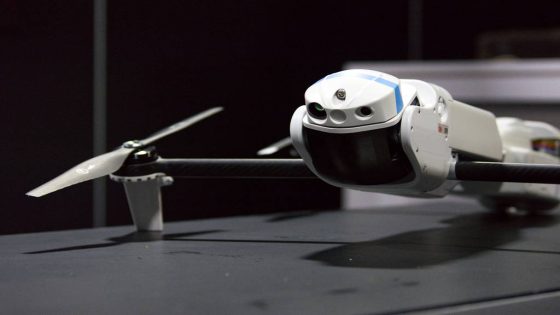Teledyne FLIR Defense plans to provide more than 100 of its Rogue 1 attack drone, capable of targeting infantry and armored vehicles, to the U.S. Marine Corps this year.
The anticipated deliveries follow the companyâs selection to the Organic Precision Fires-Light initiative, which seeks to arm Marines with easy-to-use, explosives-laden unmanned aerial systems. Teledyne is one of three companies competing for orders on the potential $249 million OPF-L arrangement; the two others are AeroVironment and Anduril Industries. AeroVironment said an initial order was valued at nearly $9 million.
Rogue 1 weighs about 10 pounds and can be retrieved from a carrying tube. Its quadcopter features fold out, and it is capable of vertical takeoff and landing, or VTOL, meaning no additional launching gear is required.
Its interchangeable warhead â for training, for taking out troops on foot, and for blasting through armor â sits on a gimbal and is coupled with sensors. Should the drone not explode or be recalled, it can be disarmed and reused thanks to a mechanical disconnect.
Brian Bills, the companyâs director of UAS products, told C4ISRNET what makes Rogue 1 stand out is its VTOL design as well as the accuracy with which troops can hit a target.
âWhile we only have a roughly 1 pound warhead, weâre able to put that entire 1 pound to incredible use, due to that precision thatâs offered by that gimbal,â Bills said in an interview. âOne of them is designed to be kind of an anti-armor, so itâll poke a hole through steel. The other one is forward-fragmenting, think of a really advanced shotgun effect with tungsten cubes, designed for anti-personnel and soft-skinned vehicles.â
RELATED
The Marine Corps has since at least 2018 sought to put armed drones in the hands of infantry squads, Marine Corps Times reported.
The popularity of such systems has only ballooned since. Footage from the Russia-Ukraine war and across the Greater Middle East showcases their deadly effect.
Rogue 1 was first supplied to U.S. Special Operations Command in 2022 for its Ground Organic Precision Strike Systems program, or GOPSS. An initial batch was also provided to the Marine Corps Warfigthing Laboratory for testing as part of the IBX-30 exercise, according to David Viens, Teledyneâs vice president of U.S. business development.
âI think the Marine Corps is going to have to do some experimentation because the capability is so novel,â he said in an interview.
âYou see Ukraine videos of Javelins hitting a T-90 tank and the turret going off the tank. We donât believe thatâs necessary,â he said. âBecause of the precision of this, I can actually create a firepower- or a mobility-kill on the tank without a catastrophic explosion.â
Colin Demarest is a reporter at C4ISRNET, where he covers military networks, cyber and IT. Colin previously covered the Department of Energy and its National Nuclear Security Administration â namely Cold War cleanup and nuclear weapons development â for a daily newspaper in South Carolina. Colin is also an award-winning photographer.
Source Agencies


